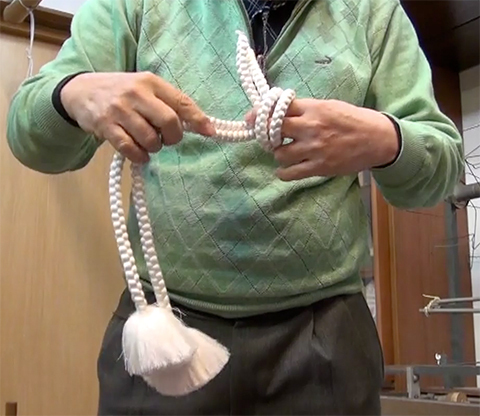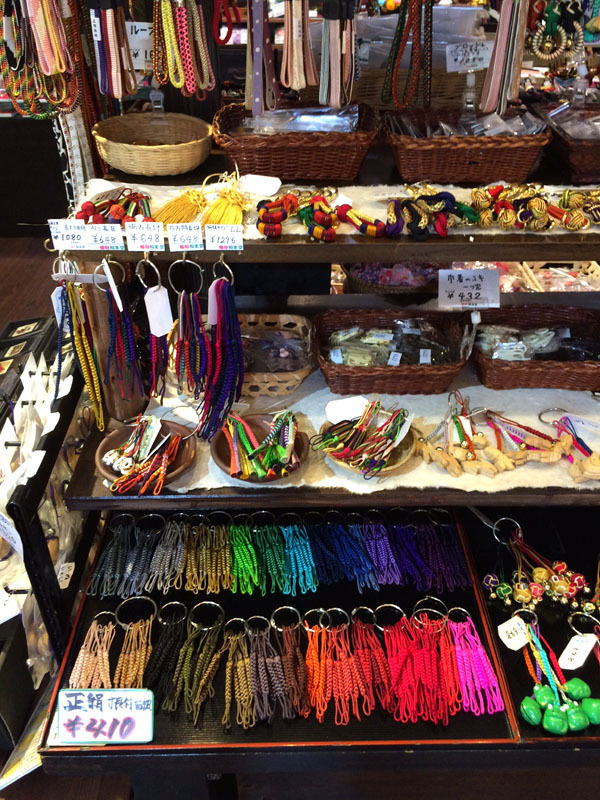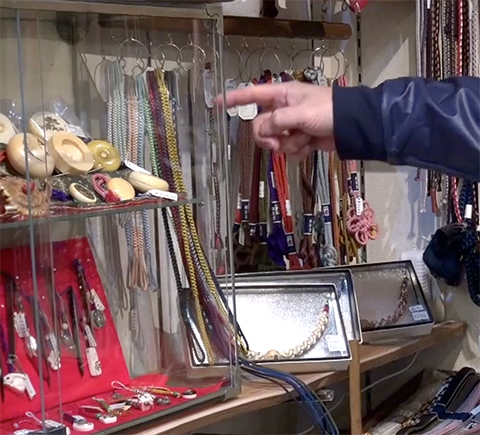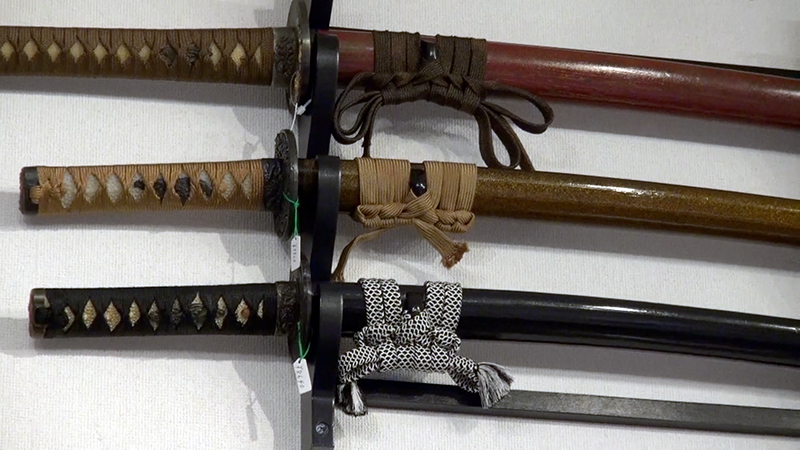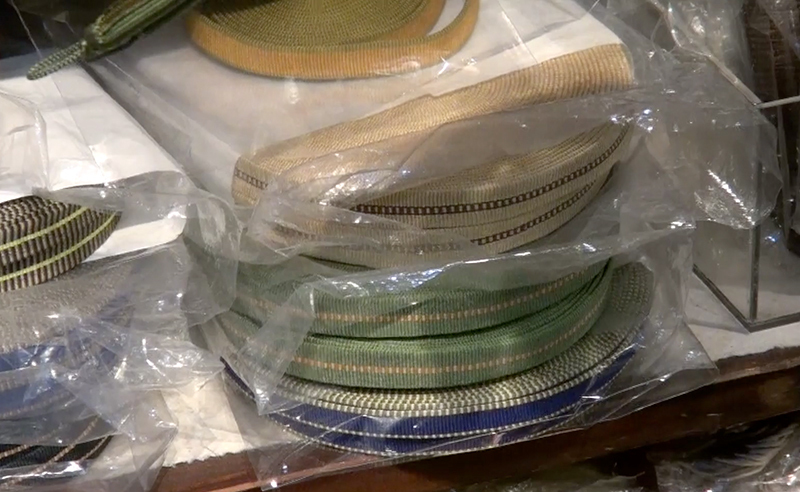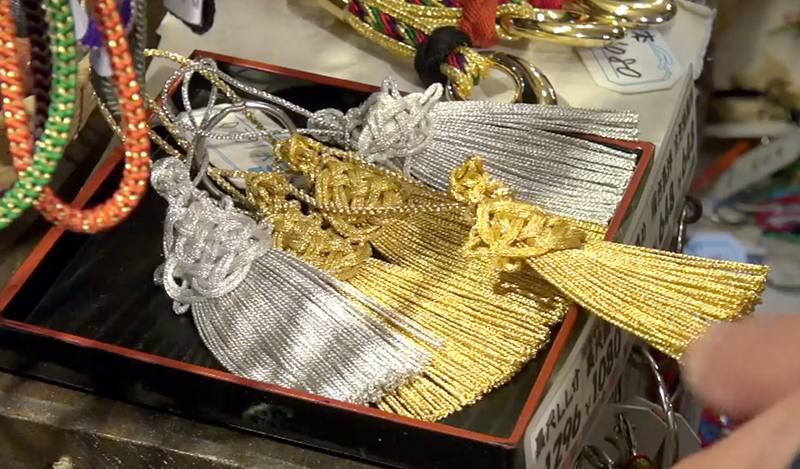Uses of Kumihimo
Q: How are these pieces of Kumihimo used?
Although these pieces of Kumihimo are not made by us, they vary in thickness, and are used for a variety of purposes. Customers also use them for their own needs. Since a variety of Kumihimo is attached to traditional Japanese tools, it has many uses. (continued in the lower column)

Q: Is Kumihimo often used for kimono and Japanese dresses?
It is not limited to kimono. It is also used for pouches, tobacco sacks and umpire's fans in sumo wrestling. In addition to them, it is used for industrial products. Although it is used for work ropes and parachutes for satellites, people often use it as shoelaces. For shoelaces, silk is easy to be soiled, and expensive, so synthetic fibers, which are stronger than silk, are often used as materials for them.
Q: What is the difference between common ropes and Kumihimo?
Many of ropes are twisted cords other than Kumihimo. Basically, the difference between ropes and Kumihimo is their structures. For Kumihimo, more than three cords are braided, but twisted ropes have a structure in which bundled threads are twisted.
Q: How long is the previously-mentioned Kaseito?
It is about 20 meters. A machine can only handle about 20 meters of it, so it is limited to that length. We do not make it by ourselves. We have asked a factory to make it by machines.
Q: What kind of difference is there between machine- and hand-made threads?
Hand-made threads are definitely better because forces can be freely applied by hands when making them. However, hand-made ones are a lot more expensive, so we cannot make them by hands.
Q: Is firmness of cords decided by braiding method? Is humidity also related to it?
Firmness of cords depends on braiding methods. We change firmness according to uses. Even when braiding methods are same, we make stiff or soft cords according to uses.
Although humidity has not much to do with, too high and low humidity makes it difficult to make cords. When the air is dry, static electricity is easily produced, so it becomes difficult.
Q: What is Kumihimo that you are now braiding used for?
This is a cord for a Japanese half-coat. This is ordered by a sumo wrestler, and its length is approximately 75cm. The length varies depending on wearers' physiques, and the standard length is about 40cm. There are a variety of cords for sumo wrestlers. We also made a cord for famous sumo wrestler "Hakuho." The biggest cord that we have made before was for "Akebono."
It is also used for tobacco sacks. Those cords were attached to tobacco sacks that were tucked into obi. In the Edo Period, some cords were as expensive as a house.
It has been made in Iga-ueno. The reason Kumihimo has been made in Iga is that a person who learned how to make Kumihimo in Tokyo returned to Iga and disseminated the braiding methods there before and after the Second World War. In the past, Kumihimo was produced in Tokyo, but it became impossible to make it in Tokyo during days of destitution before and after the Second World War, so places of production moved to countrysides. In the Iga region, many pieces of Kumihimo have been made as "Iga Kumihimo."
About Kumihimo craftsmen
Q: Kumihimo is one of the traditional crafts designated by Tokyo, isn't it?
Edo Kumihimo is designated as a traditional craftwork by Tokyo. I am also certified as a traditional craftsman, and have recommended excellent craftsmen who belong to our associations for traditional craftsmen.
Q: What are qualifications for accomplished craftsmen or the traditional craftsmen?
There is no specific qualification. If craftsmen have more than 15 years' experience, they are just eligible for the traditional craftsmen, so they do not automatically obtain it. Therefore, we recommend just one or so craftsman in several years.
Q: Are many young people trained to be craftsmen?
There are few young people. As with other traditional crafts, the number of young people is small. When we recruit trainees, many people come to our studio, but they do not continue to work with us. We also cannot offer a good salary for them.
Q: How and why do women who are now working here come to this studio?
Although I was previously enrolled in an art school, I could not hold my exhibition. I thought that I could do this work for half a day, and do my paintings for the rest of the day, so I applied for this job. When I was an elementary school student, I used to make cakes with felt and play making handicrafts, so I guess I have a bent for it.
Q: Do you think you can do something new?
It is a very fresh experience.

Introducing the store
Q: What kind of goods do you sell at your store?
We are selling sash bands, Japanese half-coat cords, sword straps and netsuke cords, as well as small items, including trendy cellphone straps and bolo ties for men. Many people have practiced "Iai," a combative quick-draw sword technique, so sword straps are much in demand. Since Iai has been spread all over the world, people come to buy them from overseas. (continued in the right column)
Q: Are there many customers who only buy cords?
We sell these cords by the piece. A wide variety of people, including professionals and amateurs, use them for various purposes.
Q: What are these cords with ornaments used for?
These ones are cords for pocket watches, and those are for "Dochugi" for women, which is put over a Japanese half-coat.
Q: Are there traditional fixed forms to tie ornament cords?
There are a variety of methods to tie those cords. There are also many ornaments, such as "Kiku Musubi," or chrysanthemum knot, which looks like a flower. Basically, Kumihimo is used after being tied, so there are a variety of forms to tie it. Kumihimo and methods to tie are closely related. Kumihimo should be easy to tie.
Q: When Kumihimo is used for Japanese swords, is it wrapped around sheathes or hafts?
A sword strap attached to a sheath is about 7 or 8 shaku (212 or 242cm), which is longer than a sash band. We sell 8 shaku straps, which are a little bit smaller in width than those of sash bands. (continued in the lower column)
Q: Can a sword strap be easily untied?
It can be easily untied. Although this is an ornamental knot, it can be easily untied. The cord wrapped around the haft is called "Tsukahimo," or haft cord, which is about 3.5-4 meter long. Tsukahimo cords are attached to all swords. For example, in samurai dramas, a samurai quickly unties a cord attached to a sheath, and use it as "Tasuki," a cord for tucking up sleeves.
A samurai bears two swords. Short Tsukahimo about 3 shaku (1m) long is used for "Wakisashi," a short sword.
Q: Do tourists from overseas also buy those cords, including sash bands?
Sash bands are recognized as ones used for kimono, so they scarcely buy them.
Q: Can't foreigners get an idea about what Kumihimo is used for when they first see it?
I think they cannot. Nowadays, foreigners but it as a bracelet. Since Kumihimo was used in a film titled "Kimi no Naha," or your name, many people have recently come to our store seeking it.
Q: Are products made in this studio also sold overseas?
Although we do not directly sell those products overseas, since sword straps are difficult to obtain in foreign countries, inquiries for those straps sometimes come from abroad or foreign tourists.
Q: This is "Sanadahimo" that was introduced in a long-running TV drama, isn't it?
A company that has made Sanadahimo is located in Tokyo, so we buy in a stock of it from the company. Sanadahimo is a fabric of which warp and weft are woven by a loom, so it is not Kumihimo.
Q: What is Sanadahimo used for?
It is most often used for cords of tea things' boxes. There are some rules that "Omotesenke" and "Urasenke," two schools of the tea ceremony, should use particular colors for Sanadahimo. (continued in the lower column)
Q: China and South Korea celebrated the Lunar New Year the other day. Did customers come to your store?
Many customers visit our store just before and after the Lunar New Year. Auspicious ornamental knots, including traditional "Kamemusubi," or turtle knot, and "Ebimusubi," or prawn knot, are popular among them. Although those knots were attached to silk wrapping clothes used for happy events in the past, I do not know how people are now using them. Japanese have a custom to attach things like "Netsuke," an intricately carved ivory, coral, quartz or other toggle, to their tobacco sacks and wallets since olden days. There is no such custom in other countries, isn't it? When cellular phones appeared, Japanese put straps to cellular phones as a matter of course, but it is less common in other countries. For that reason or something, iPhone does not have a hole for straps. However, it seems that the increasing number of foreigners attach straps to cellular phones like Japanese young people partly because of their interest in Japanese cultures and animation.











